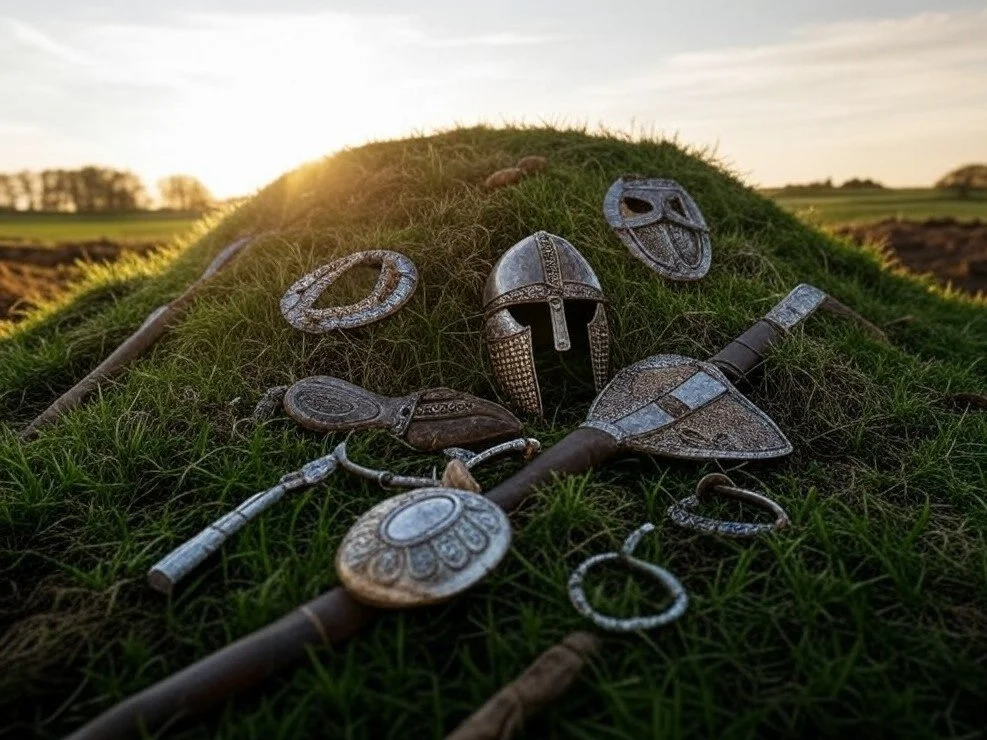Introduction
The discovery of the Sutton Hoo treasure in 1939 stands as one of the most significant archaeological finds in British history. Unearthed in Suffolk, England, this burial site contained an array of exquisite artifacts, including an iconic helmet, gold ornaments, and a complete ship burial, shedding light on the wealth, craftsmanship, and cultural sophistication of the Anglo-Saxon period. The Sutton Hoo treasure revolutionized the understanding of early medieval England and its connections with wider European and Scandinavian cultures.
The Discovery of Sutton Hoo
In the summer of 1939, as Europe stood on the brink of World War II, amateur archaeologist Basil Brown, under the patronage of landowner Edith Pretty, began excavating the Sutton Hoo burial mounds. What he uncovered exceeded all expectations: the remains of a massive ship, nearly 27 meters (88 feet) in length, with a chamber at its center containing a vast collection of grave goods. The burial was later attributed to an elite individual, possibly King Rædwald of East Anglia (c. 599–624 CE), though definitive identification remains elusive.
Key Artifacts and Their Significance
The Sutton Hoo treasure included a remarkable array of artifacts that highlighted the artistic and martial culture of the early Anglo-Saxons:
The Sutton Hoo Helmet – One of the most iconic artifacts of early medieval Europe, this iron helmet with a distinctive faceplate and decorative motifs symbolizes the warrior elite of the Anglo-Saxon era.
The Shoulder Clasps and Belt Buckle – Crafted in gold and inlaid with garnets, these finely detailed pieces demonstrate advanced metalworking skills and aesthetic refinement.
The Sword and Shield – Essential symbols of status and power, the sword featured a pattern-welded blade, while the shield boasted elaborate decorations and metal fittings.
Silverware from the Byzantine Empire – The presence of high-quality silver vessels suggests extensive trade networks linking Anglo-Saxon England to the Eastern Roman (Byzantine) world.
Coins and Other Grave Goods – The discovery of Merovingian gold coins provided crucial dating evidence and indicated diplomatic or trade connections with continental Europe.
Cultural and Historical Implications
The Sutton Hoo discovery transformed historical perspectives on the so-called Dark Ages, revealing that early medieval England was not an isolated, primitive society but a flourishing kingdom engaged in extensive cultural and economic exchanges. The burial’s grandeur suggests a highly stratified society with a ruling elite who had access to foreign luxury goods and sophisticated artistic traditions. The ship burial tradition also aligns Sutton Hoo with similar practices found in Scandinavia, hinting at the deep ties between Anglo-Saxon England and the wider Germanic world.
Archaeological and Conservation Efforts
Since its discovery, the Sutton Hoo site has been subject to extensive archaeological investigation and conservation. Modern techniques such as ground-penetrating radar and digital reconstruction have enhanced understanding of the site’s layout and the decay of organic materials over time. The artifacts, now housed at the British Museum, continue to be studied for insights into Anglo-Saxon society, warfare, and craftsmanship.
Conclusion
The Sutton Hoo treasure remains a cornerstone of early medieval studies, offering unparalleled insights into the Anglo-Saxon elite, their artistic achievements, and their far-reaching connections. This extraordinary find continues to captivate historians and archaeologists, ensuring its place as a defining moment in British archaeological history. As research progresses, Sutton Hoo’s legacy will only deepen, reaffirming its role in illuminating the rich and complex tapestry of Anglo-Saxon England.







